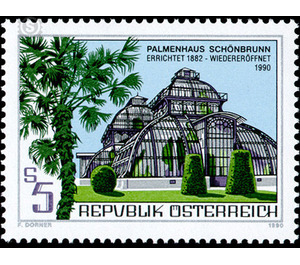opening - Austria / II. Republic of Austria 1990 - 5 Shilling
Theme: Flora
| Country | Austria / II. Republic of Austria |
| Issue Date | 1990 |
| Face Value | 5.00 |
| Color | multi-colored black |
| Printing Type | Photogravure |
| Stamp Type | Commemorative |
| Item Type | Stamp |
| Chronological Issue Number | 1354 |
| Chronological Chapter | OOS-OE2 |
| Michel ID | OOS 2011 |
| SID | 850895 |
| In 68 Wishlists | |
On 19 June 1882, the Palm House was opened after two years of construction. The Habsburgs' growing collection of plants had made the construction necessary, and so Emperor Franz Joseph I had the court architect F. v. Chr. Segenschmid commissioned the planning of the Palm House. Together with the structural engineer Ing. S. Wagner and the yard iron engineer I. Grindl he realized the largest (28 m height, 25 m length) glass-iron construction of its kind on the European continent even today. On February 7, 1945, the Palm House was hit by three American aerial bombs. Most of the botanical treasures froze as a result of total glass breakage at deep winter temperatures. It was not until 1953 that the Palm House was reopened. The damage in construction, pollution and blindness of the glazing, which began in the following decades, forced a renewed general refurbishment in 1986, after which the Palm House was reopened to the public on 30 November 1990.
| Condition | Name | In Stock | Price | Price + Shipping | Store | |
|---|---|---|---|---|---|---|
 | Unmounted Mint ** | opening - Austria / II. Republic of Austria 1990 - 5 Shilling | 1 | US $0.815 | US $4.06 |  FILATELIELOKET (0) FILATELIELOKET (0)Shipping US $3.25 Minimum Order US $2.72 |


